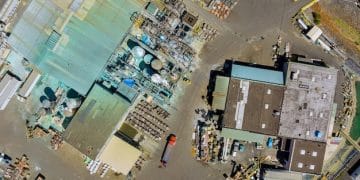Labor Costs in Mexico for US Manufacturing Relocation

For US companies considering manufacturing relocation, understanding labor costs in Mexico is paramount, as the nation offers competitive wages and a skilled workforce that significantly impacts overall production expenses and operational efficiency.
As US companies increasingly explore nearshoring and reshoring strategies, Mexico frequently emerges as a primary contender due to its strategic location and burgeoning industrial capabilities. A thorough understanding of labor costs in Mexico: A detailed analysis for US companies considering manufacturing relocation is not merely a line item on a budget; it is a critical determinant of competitive advantage, operational viability, and long-term success.
Understanding the Landscape of Mexican Labor Costs
Mexico’s labor costs are often cited as a key driver for foreign direct investment, particularly from its northern neighbor. However, a superficial glance at hourly wages can be misleading. A comprehensive analysis demands looking beyond raw numbers to encompass social benefits, worker productivity, and regional variations, which collectively paint a more accurate picture of the true cost of labor.
The allure of Mexico stems from a compelling combination of factors. Proximity to the US market minimizes logistics costs and enhances supply chain resilience. An increasingly skilled workforce, particularly in advanced manufacturing sectors, addresses concerns about quality and technical capability. Yet, it is the fundamental structure of labor remuneration that often seals the deal for many US firms.
Average Wage Rates Across Key Sectors
Mexico’s average wages vary significantly by industry and region. Entry-level manufacturing positions in the northern border states, known for their maquiladoras, typically command lower hourly rates than skilled technical roles in automotive or aerospace hubs in central Mexico. This regional disparity allows companies to strategically locate based on their specific labor needs and budget.
- Manufacturing Operatives: Hourly rates for assembly line workers typically range from $2.50 to $4.00, influenced by states like Nuevo León or Chihuahua.
- Skilled Technicians: For positions requiring specialized training, such as maintenance or quality control, wages can range from $5.00 to $8.00 per hour.
- Engineers: Highly skilled engineers, especially those with specific industry experience, may command $10.00 to $15.00+ per hour, still significantly lower than US counterparts.
These figures represent base wages, which are only one component of the total labor cost. Companies must also factor in a range of mandatory and customary benefits that contribute substantially to the overall expense. Understanding these additional costs is crucial for accurate financial forecasting and competitive analysis.
The dynamic nature of the Mexican labor market also means that wage rates are subject to change based on economic conditions, inflation, and union negotiations. Staying informed about these trends is an ongoing requirement for any firm operating in the country. This proactive approach helps mitigate unexpected cost increases and ensures labor strategies remain aligned with market realities.
Mandatory Benefits and Social Security Contributions
Beyond the base wage, Mexican labor law mandates a series of benefits and contributions that significantly inflate the true cost of an employee. These benefits are designed to provide social protection and worker welfare, and compliance is rigorously enforced. US companies must integrate these into their financial models from the outset to avoid miscalculations.
The Mexican social security system, known as IMSS (Instituto Mexicano del Seguro Social), is a comprehensive program covering healthcare, pensions, and occupational risks. Employer contributions to IMSS are a substantial component of labor costs, varying based on the employee’s salary and risk classification of the role.
Key Mandatory Contributions and Benefits
- Social Security (IMSS): Employers contribute approximately 20-30% of an employee’s base salary to IMSS, covering medical services, disability, retirement, and childcare.
- Housing Fund (INFONAVIT): A mandatory 5% of the employee’s base salary is contributed by the employer to support housing loans.
- Retirement Savings (SAR): Employers contribute 2% of the employee’s base salary to their individual retirement accounts.
- Payroll Taxes: State payroll taxes (Impuesto Sobre Nóminas) typically range from 2-3% of the total payroll, varying by state.
In addition to these statutory contributions, Mexican law also mandates specific benefits, such as Christmas bonus (Aguinaldo) and vacation premium. The Aguinaldo is equivalent to at least 15 days of salary, paid before December 20th each year. The vacation premium is a minimum of 25% of the employee’s vacation pay, paid when vacation days are taken.
These mandatory benefits, when combined with social security contributions, can add an additional 30-40% on top of the base wage. Neglecting these seemingly indirect costs can lead to significant budgetary shortfalls and compliance issues. Therefore, any detailed analysis must factor in these percentages accurately.
Understanding the intricacies of these mandates requires careful legal and financial due diligence. Many US companies choose to partner with local payroll service providers or human resources consultants to ensure full compliance and optimize these costs where possible, leveraging expert knowledge of local regulations and practices.
Productivity and Workforce Quality: The Intangible Values
While raw labor costs are a primary consideration, the efficiency and skill level of the workforce play an equally vital role in determining overall manufacturing competitiveness. A lower hourly wage loses its appeal if it results in significantly lower productivity or requires extensive retraining to meet quality standards. Evaluating labor in Mexico must extend beyond mere monetary figures to encompass human capital metrics.
Mexico has made substantial strides in developing a skilled labor force, particularly in advanced manufacturing sectors like automotive, aerospace, and electronics. This is largely due to increased investment in technical education and vocational training programs, often supported by partnerships between government, industry, and educational institutions. This concerted effort ensures a steady supply of workers with relevant expertise.

Measuring Productivity and Its Impact
Productivity in Mexico can often rival or even exceed that of workers in other emerging markets, thanks to strong work ethics and adaptability. Many companies report that, once trained, Mexican employees demonstrate high levels of efficiency and dedication. The challenge lies in effective training and management that leverages existing skills while developing new ones.
- Training Investments: Initial investment in training programs for new hires is essential, but often yields long-term returns in efficiency and quality.
- Employee Retention: High retention rates in Mexico’s manufacturing sector can lead to accumulated experience and a more stable, productive workforce.
- Adaptability: Mexican workers are often noted for their ability to quickly adapt to new technologies and processes, a crucial trait in dynamic manufacturing environments.
When comparing labor costs directly, it’s important to consider “cost per unit produced” rather than simply “cost per hour.” A slightly higher hourly wage for a more productive worker can result in a lower per-unit cost, making the seemingly more expensive option ultimately more economical. This granular analysis is key for evaluating true efficiency.
The quality of Mexico’s workforce is also bolstered by its strong cultural ties and proximity to the US. This facilitates easier communication, cultural exchange, and direct oversight, often leading to better integration of teams and more efficient problem-solving compared to more distant manufacturing locations. These elements, while harder to quantify, contribute significantly to operational success.
Regional Variations and Specific Industry Considerations
Mexico is a vast country, and generalizing its labor market can be a significant oversight. Labor costs, availability of skilled workers, and supporting infrastructure vary considerably from one region to another. US companies considering relocation must conduct detailed regional analyses to find the optimal location that aligns with their specific industry and operational needs.
The northern border states, such as Baja California, Sonora, Chihuahua, Coahuila, and Nuevo León, are historically strong manufacturing hubs due to their direct proximity to the US. This proximity offers logistical advantages but often comes with slightly higher labor costs and greater competition for skilled talent.
Key Manufacturing Regions and Their Impact on Labor
- Northern Border States: Higher degree of industrialization, established supply chains, but potentially higher wage demands due to competition.
- Central Mexico (e.g., Querétaro, Guanajuato, Aguascalientes): Emerging as strong automotive and aerospace clusters; offers growing talent pools and competitive labor costs.
- Southern Mexico: Less developed industrially, generally lower labor costs, but may lack robust infrastructure and skilled labor in specialized sectors.
Industry-specific demands also play a critical role. The automotive sector, for instance, requires specialized engineering and technical skills, which are more readily available in established automotive manufacturing clusters. The electronics industry, on the other hand, might prioritize access to a high volume of assembly line workers with basic technical skills.
Beyond wages, regional differences in infrastructure, local taxes, union activity, and availability of related services (like logistics, warehousing, and tooling suppliers) can influence the overall cost and ease of doing business. A holistic approach to site selection considers all these factors in conjunction with labor costs.
Furthermore, the specific requirements of a US company – whether it’s high-volume, low-margin production or high-mix, low-volume, high-value manufacturing – will dictate the ideal regional fit. Matching the operational model to the regional labor market characteristics is crucial for achieving cost efficiencies and operational excellence.
Navigating Legal Frameworks and Unionization
Operating in Mexico requires a thorough understanding of its labor laws and the landscape of unionization. Mexican labor law, while protective of workers’ rights, is generally favorable to employers when compared to some other Latin American countries. However, non-compliance can lead to significant penalties and operational disruptions.
The Federal Labor Law (Ley Federal del Trabajo) governs the rights and obligations of both employers and employees. It covers aspects such as working hours, minimum wage, termination procedures, and collective bargaining. Employers must adhere strictly to these regulations to maintain a stable and compliant workforce.
Dealing with Union Presence
Unionization in Mexico is common, particularly in large manufacturing operations. Companies often encounter established unions or may face efforts to organize their workforce. Successfully navigating union relations requires transparency, fair practices, and adherence to collective bargaining agreements.
- Collective Bargaining Agreements (CBAs): Many factories operate under CBAs, which dictate wages, benefits, and working conditions. Understanding and adhering to these agreements is non-negotiable.
- New Labor Reforms: Recent labor reforms in Mexico aim to promote greater transparency and democracy in union elections and collective bargaining, impacting how companies engage with unions.
- Strike Protocol: While strikes are less common in modern Mexican industrial settings, companies must understand the legal protocols and their rights and obligations should one occur.
US companies should engage with legal counsel specializing in Mexican labor law early in their relocation process. This proactive approach helps in drafting compliant employment contracts, understanding termination clauses, and establishing fair internal policies that meet local regulations.
Moreover, fostering positive employer-employee relations, beyond mere compliance, is key to preventing disputes and fostering a productive work environment. Investing in fair wages, good working conditions, and clear communication can significantly mitigate labor risks and enhance overall operational stability.
Total Cost of Ownership: Beyond Wages
When US companies assess manufacturing opportunities, focusing solely on direct labor costs can lead to incomplete and potentially misleading conclusions. A true “total cost of ownership” (TCO) analysis is essential, integrating every expense from raw materials and logistics to utilities, regulatory compliance, and cultural integration. Labor, while significant, is just one piece of this complex puzzle.
The cost advantages of Mexican labor can be offset if other operational expenses are not adequately managed. For instance, while hourly wages might be lower, energy costs in some Mexican regions could be higher than in the US. Similarly, the efficiency of local logistics infrastructure or the availability of specialized suppliers can dramatically impact overall production costs and timelines.

Components of Total Cost of Ownership
- Logistics and Transportation: Proximity to the US reduces shipping times and costs, a significant advantage over Asian manufacturing.
- Utilities and Infrastructure: Assess the cost and reliability of electricity, water, and internet services, which can vary by region.
- Taxes and Incentives: Understand federal, state, and local taxes, as well as any incentives or subsidies available for foreign investors.
- Regulatory Compliance: Costs associated with licenses, permits, environmental regulations, and ongoing legal compliance.
- Cultural and Management Overhead: Expenses related to expatriate staff, cross-cultural training, and managing international teams.
A comprehensive TCO model allows US companies to compare the true economic viability of manufacturing in Mexico versus other locations, including domestic production. This approach helps identify unforeseen expenses and accurately projects long-term profitability. It demands a granular review of every operational facet.
Furthermore, the often-overlooked benefits of nearshoring, such as reduced lead times, improved supply chain agility, and enhanced quality control due to closer oversight, contribute significantly to TCO. These qualitative advantages, while not appearing directly on a labor cost spreadsheet, greatly enhance overall business value and market responsiveness.
Ultimately, a successful manufacturing relocation to Mexico hinges on more than just securing competitive labor rates. It requires a strategic and holistic approach, integrating every financial and operational detail into a robust TCO analysis. This diligent preparation allows US companies to harness Mexico’s economic advantages while mitigating potential risks and ensuring a sustainable manufacturing footprint.
| Key Point | Brief Description |
|---|---|
| 📊 Competitive Wages | Mexico offers significantly lower base wages compared to the US, particularly in manufacturing. |
| 💼 Mandatory Benefits | Social security, housing funds, and vacation premiums add 30-40% to base wage costs. |
| 🌎 Regional Variations | Labor costs and talent availability vary widely by state and industrial cluster. |
| 🔍 Total Cost of Ownership | Consider all costs—utilities, logistics, regulatory—not just wages, for a full financial picture. |
Frequently Asked Questions
▼
Yes, base wages in Mexico are significantly lower than in the US. However, a comprehensive analysis must include mandatory benefits, social security contributions, and payroll taxes, which can add substantial percentages to the base wage. Even with these additions, the total labor cost in Mexico typically remains more competitive.
▼
The primary “hidden” costs are mandatory benefits and social security contributions, such as IMSS (social security), INFONAVIT (housing fund), and SAR (retirement savings), plus required annual bonuses like Aguinaldo. These can increase the total labor cost by 30-40% beyond basic wages. Additionally, training new employees can be a factor.
▼
While often starting at a lower point due to less automation or different operational practices, Mexican workers are highly adaptable and, with proper training and management, can achieve productivity levels comparable to or even exceeding those in other emerging markets. The key is to measure “cost per unit produced” rather than just hourly wages.
▼
Regional differences are significant. Northern border states tend to have slightly higher labor costs due to higher industrialization and demand, while central Mexican states offer competitive rates and skilled labor, especially in specialized industries. Southern regions might have lower costs but less developed infrastructure and specialized talent pools.
▼
Unionization is common in Mexican manufacturing. Companies must understand and comply with federal labor laws and collective bargaining agreements. Recent labor reforms aim for more transparent union processes. Proactive engagement with legal counsel and fostering positive employee relations are crucial for managing union dynamics effectively.
Conclusion
The journey of assessing labor costs in Mexico: A detailed analysis for US companies considering manufacturing relocation extends far beyond a simple comparison of hourly wages. It demands a nuanced, multi-faceted approach that integrates mandatory benefits, social security contributions, regional variations, workforce productivity, and the intricate legal and union frameworks. For US companies, Mexico presents a compelling value proposition rooted in competitive labor rates and an increasingly capable workforce. However, only through a comprehensive total cost of ownership analysis, considering every direct and indirect expense, can businesses truly unlock and sustain these advantages. Strategic planning and diligent due diligence are the bedrock upon which successful nearshoring operations in Mexico are built, ensuring both economic efficiency and operational resilience in a rapidly evolving global manufacturing landscape.





